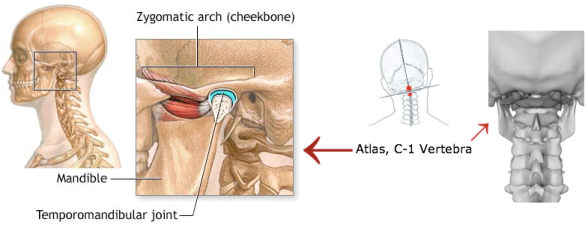Sick and Tired of TMJ
Jaw pain, clicking, cheek soreness, teeth grinding, neck pain and headaches are symptoms associated with a condition that over ten million Americans suffer from: TMJ Disorder. It’s a problem that can impact any activity involving the muscles of your face like chewing, swallowing, and yawning. Even talking or laughing can elicit pain.
It’s common for TMJ sufferers to seek relief from dentists. But I’m going to tell you about an alternative that you’re probably not as familiar with… it’s called Upper Cervical Care.
From the side view, the TMJ is located a little more than a finger’s width away from the top bone of your neck. This part of the spine is referred to as the C1 vertebra, or atlas. The position of your atlas bone may play a role in the pain associated with TMJ disorder.

It’s common for TMJ sufferers to seek relief from dentists. But I’m going to tell you about an alternative that you’re probably not as familiar with… it’s called Upper Cervical Care.
The Anatomy
TMJ is short for “temporomandibular joint” and describes the hinge between your skull’s temporal bone and mandible – better known as your jaw. It’s tempting to assume that this joint needs treatment when the area hurts. In some cases it will; but not always. There can be more to the equation… Take a look at the illustration below.From the side view, the TMJ is located a little more than a finger’s width away from the top bone of your neck. This part of the spine is referred to as the C1 vertebra, or atlas. The position of your atlas bone may play a role in the pain associated with TMJ disorder.

If you’re grateful for the ability to look up, down, side to side, and all around you, thank your C1 vertebra. This freedom of movement comes with a price, however. Among the 24 bones of your spine, C1 is the most prone to misalignment. Injuries, accidents, and traumas to the body can wedge or lock this bone into positions that create pressure and irritation within the surrounding areas… quite possibly the TMJ.
Neighbors Without a Fence
Think of the atlas and TMJ as neighbors without a privacy fence. TMJ is friendly, but he works long hours and likes to keep to himself. Atlas is the kid next door who sometimes likes to play in his neighbor’s yard. It’s not a big deal at first, but over time this makes old TMJ crotchety and irritable.
The Upper Cervical Solution
Chiropractors who focus exclusively on the upper cervical spine will analyze the relationship between your head and neck. They’ll take x-rays using specialized angles and equipment to measure how your C1 is misaligned. Using this information, the doctor will perform a customized adjustment that reduces (or eliminates) the pressure/irritation caused by atlas.
In time, the body will learn to hold C1 in this improved position, and symptoms of its misalignment diminish.
Does This Help All Types of TMJ?
TMJ can be caused by different factors, so it’s important to have realistic expectations.
There’s not going to be one solution that works for everybody. Sometimes TMJ develops in adulthood simply because of a combination of stress and poor lifestyle choices. For others, it develops following an injury. In these instances, Upper Cervical Care can be beneficial.
For patients who’ve had TMJ problems for as long as they can remember (ever since childhood), it’s probably not the answer. Situations like this often involve abnormal condylar surfaces of the jaw and may require surgical procedures to correct.
What Now?
If you’re looking for an affordable and non-invasive way to relieve your TMJ pain, locate an Upper Cervical practitioner near you. Here’s a helpful online directory. Schedule a consultation, undergo their evaluation, and see what your doctor finds. If you have TMJ pain and they uncover an atlas misalignment, there may be a correlation.
In my clinical experience, patients with TMJ disorders notice an improvement fairly quickly. Monitor your changes over the course of 3-4 corrections to adequately gauge
 05/29/2012
05/29/2012 
No comments:
Post a Comment